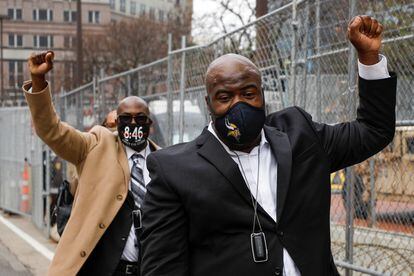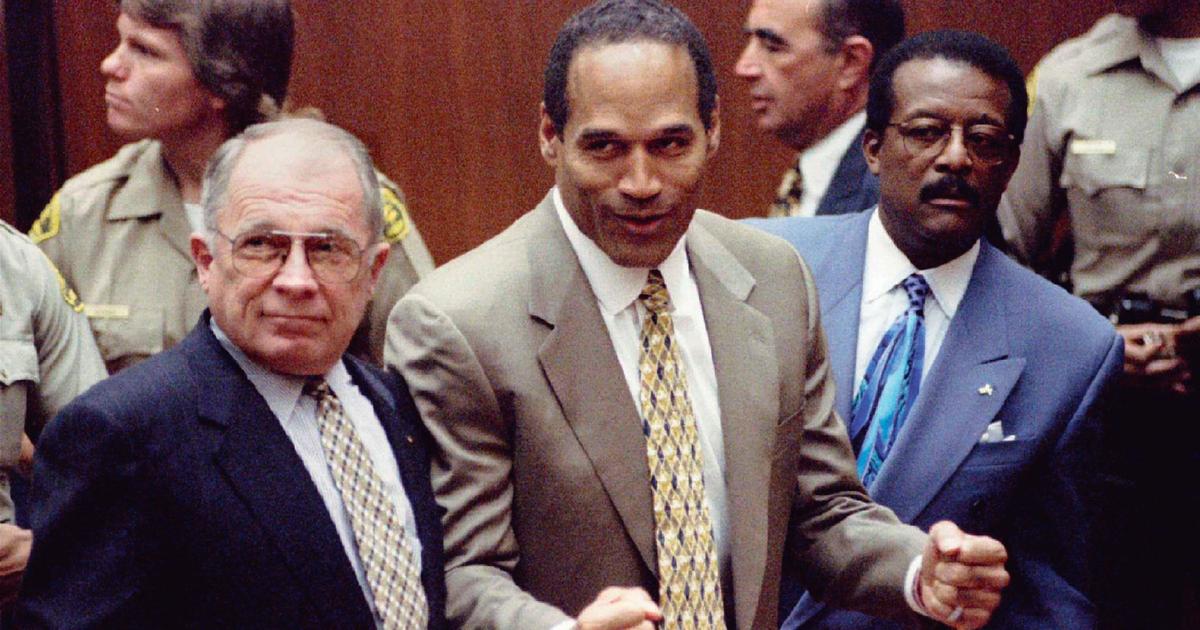Philonise and Rodney, George Floyd's brothers, raise their arms during one of the days of the trial for the 'Floyd case', in Minneapolis.NICHOLAS PFOSI / Reuters
The use of force by the police, the possible effect of drugs on the victim and the complaints of witnesses at the crime scene have been the themes that have marked the first eight days of the trial for the death of George Floyd , the African-American who died under the knee of a policeman - now tried for murder - and who has become a symbol of the racial struggle in the United States.
The beginning of the process was led by the emotional testimonies of those who witnessed the arrest that ended in death on May 25, 2020. In recent days, the police authorities have explained that the technique of nailing the knee in Floyd's neck - when he was handcuffed - applied by Derek Chauvin, the former agent accused of murdering the African American, violated the rules in those circumstances.
These are the keys addressed so far in the trial:
Floyd's cause of death
The main weapon of the Minneapolis prosecutor's office to convince the jury that Chauvin caused Floyd's death is the brutal video where the African American is seen immobilized by three agents while screaming that he cannot breathe until he vanishes.
The disproportionate use of force applied by Chauvin is the trump card of the prosecutors, who have tried to show that he violated police protocol when exercising it.
The defense of the ex-agent, for its part, wanted to argue that the cause of death was a cardiac arrhythmia, a product of the detainee's poor health, as well as the remains of fentanyl and methamphetamine found in his blood.
It has also said that the defendant's use of force was "reasonable."
The resistance
At the trial, images of Floyd prior to his arrest came to light for the first time.
He looked happy in the store where he bought tobacco with a $ 20 bill, supposedly fake.
Once in the car, with a gun pointed at his head, an officer ordered him to get out and Floyd, terrified, replied: "Don't shoot me."
From then on, the African American resists getting into the police car, claiming that he suffers from claustrophobia and that he cannot breathe.
Chauvin's defense has reinforced their argument that Floyd posed a threat by kicking him while resisting arrest.
But the police authorities have explained that, once handcuffed, he no longer represented a danger.
Police Charge Chauvin
The Chief of the Minneapolis Police, Medaria Arradondo, accused Chauvin, who was his subordinate, of having “absolutely” violated police protocol, which obliges not to use force when the detainee has adverse medical conditions or is under the influence of the drugs.
Floyd claimed claustrophobia and was high on drugs.
"Once Mr. Floyd stopped resisting, and certainly once he was getting out of his mind and trying to verbalize it, that [the knee-to-neck tactic] should have stopped," Arradondo said.
Authorities complicate the defense of the accused
Chauvin's lawyers defend that their client acted according to what he learned during training at the Minneapolis Police Department, the city where the events took place.
However, the head of the security body clarified that the technique of nailing the knee when the detainee is handcuffed and does not show resistance is not taught in his department.
This clarification has been reinforced by the coaches of the police officers who have paraded through the stage.
There has been a consensus that Chauvin's use of force was excessive and that it violated police protocol.
That complicates the arguments of the defendant's defense.
The remorse of the witnesses
The trauma that emerges from those who believe they should have done more to prevent Floyd's death has been present in most of the arrest witnesses.
Darnella Frazier, who recorded the video that went around the world with her mobile, said that there are nights when she apologizes to Floyd for not having done more.
Genevieve Hansen, an off-duty firefighter and emergency medical technician, was prevented from assisting the African American when he was unconscious.
Through tears she described the anguish of not being able to provide Floyd with the medical help he needed.
The distracting effect of witnesses
Chauvin's defense has sought in their interrogations of the police authorities to validate their argument that the witnesses who spoke out against the arrest and treatment of Floyd caused the police officer to be distracted.
Chauvin's lawyer has argued that the anger and possible threat posed by the dozen citizens present distracted his client from the attention to the African American.
In the videos you can see how those present were increasingly upset while Chauvin ignored the pleas of Floyd, who claimed that he could not breathe.
There were some who insulted the officers, after demanding that they take the detainee's pulse and leave him alone when he was no longer resisting arrest.
Police authorities have admitted that shouting threats may be a distraction.
Subscribe here
to the
EL PAÍS América
newsletter
and receive all the informative keys of the current situation in the region.




